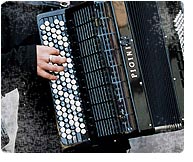|
|
 |
 The Dangers of Skinheads, Horse Carriages, and Small Children:
The Dangers of Skinheads, Horse Carriages, and Small Children:
The Life and Times of An Accordion Trio… On The Street
Janusz Wojtarowicz has seen every human reaction to his instrument. The Polish accordionist has performed on the streets of eleven countries and the experience—along with his personal dislike for emotionless interpretation of classical standards—drove him to seek out a new model of livelihood on the accordion. Wojtarowicz founded the accordion ensemble known as the Motion Trio, whose debut CD, titled Pictures from the Street, will be released by Asphalt Tango Records (Harmonia Mundi USA) on January 11, 2005.
The album—whose vanguard sound collages range somewhere between minimal music, jazz and rock with traditional accordion styles thrown in for good measure—was recorded pretty much the way you would expect a few street musicians to record it: in one day. These are musicians who honed this repertoire over several years before a huge diversity of audiences on the streets.
“Once I was performing in Germany to a huge crowd,” recalls Wojtarowicz. “Suddenly the crowd disappeared and I saw two pairs of soldier boots standing before me. I was too scared to look up so I kept playing and staring at the ground. When the piece was over, I looked up and there were two huge skinheads standing there. One of them threw a franc into my box and patted me on the shoulder. I guess skinheads like the accordion!"
“In Rome, I played in the metro station, because it had great acoustics,” Wojtarowicz launches into another story. “Every day for a month a priest passed by and gave me ten dollars. It was a great spot. But one day the police told me I wasn’t allowed to play there. The next day I tried again and the police were putting up a sign that said, ‘Playing Prohibited.’ I was upset, but I went back there several years later, and this special monument to me is still there.”
“In Vienna, I played between the Vienna Opera house and the famous Steppenplatz church,” says Wojtarowicz. “This is a traditional place for street musicians to play, but nobody was putting money in my box. Finally, another musician told me my box was too close; that it should be five meters away for people to drop money in. But within five minutes my box was run over and smashed by a horse and carriage being used to advertise a Mozart concert.”
These dangerous and humorous stories belie the seriousness with which the Motion Trio take on their instruments and in their musical mission. “Generally on the street, the most dangerous audiences are the mothers with little children, because they disturb you,” Wojtarowicz explains. “They come to you and ask questions like ‘What are you doing?’ It’s funny, but they disturb you in your work.”
The Polish Ministry of Culture found the work so serious that they commissioned Pigini—the maker of the most expensive, custom-made accordions, or the “Rolls Royce of accordions” as Wojtarowicz calls it—to create the one keyboard accordion and two button accordions on which the Motion Trio plays. The 18,000 Euro instruments have a much wider range (including a rich deep bass) than the semi-professional accordions most people are used to hearing. The instruments use special handmade reeds and are custom-fit to the size and shape of the players’ hands. They were built especially to be played together.
Their range is further expanded with a variety of unconventional accordion techniques. Wojtarowicz has written an entire book for composers to understand the range of sounds available. Listen for accentuated vibrato, the shaking and scraping of the bellows, percussion on the accordion, glissando, and unique articulation of the notes. The techniques, diverse repertoire, and unconventional yet serious approach, find the Motion Trio doing for the accordion what the Kronos Quartet did for the chamber group.
The idea for the accordion trio came when Wojtarowicz was explaining to some students that three accordions alone could replicate an entire chamber orchestra. “The three of us can create sounds which would require about twenty-one people in a string orchestra,” he exclaims.
“Our idea is to take this instrument, which is only thought about for weddings or polka or tango, and to make it as serious as any other classical instrument,” says Wojtarowicz. “We want to show the world that this is a versatile instrument that can play everything from contemporary classical music to folk or even avant garde music.”
|
|
 |
|
|
|